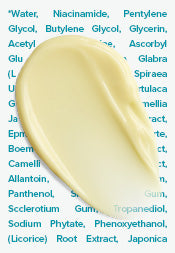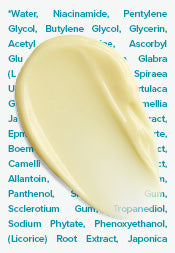Superfoods for All Skin Types
In the world of skincare, there is no single best ingredient for perfect skin. Just like your body needs a variety of healthy foods to thrive, your skin needs a mix of beneficial ingredients to look its best. One of the ways is to introduce different types of natural skincare products made with superfoods into your skincare routine – they’re one of the secrets to getting better skin.
If there’s such a thing as beauty foods for skin, superfoods are it. Superfoods are nutritionally dense foods that supply the skin with antioxidants. These natural superfoods also deliver essential fatty acids and vital replenishing ingredients to enrich and strengthen our skin’s barrier. Going further, some superfoods do all of that and provide soothing skincare benefits.
Whether you’re looking for foods for clear skin, foods for glowing skin, or just want skin that looks and feels its best, both eating and applying superfoods can help. After examining the research at Paula’s Choice Skincare, we’ve come up with a list of the top 10 superfoods for skin which we use in our natural skincare products.
Superfoods: Top 10 Natural Skincare Ingredients
Before you dive into this list, know that these picks aren’t the only superfoods for your skin to consider. Just as there are lots of antioxidants that can help your skin, there are lots of superfoods that enhance skin’s appearance. These superfoods are among the most well-researched and can be found readily in Paula’s Choice products:
Flaxseed oil
Flaxseed oil (also known as linseed oil) is a rich source of omega-3 fatty acids, which has a moisturising and calming action on the skin. We include flaxseed oil with other omega fatty acids in our Omega+ Complex Moisturizer.
Chia seed oil
Chia is another rich source of omega-3 fatty acids, along with other replenishing fatty acids and potent antioxidants. It works to visibly reduce redness and is a great skincare ingredient for sensitive skin. This natural skincare superfood is present in our Omega+ Complex Serum.
Blueberries
Like all dark and brightly coloured berries (the lot of which count as superfoods), blueberries are a phenomenal source of antioxidants known as polyphenols, which have a notable ability to visibly calm skin. Our skin is bombarded daily with things that can sensitise it, so anything you can do to defend against this damage leads to better skin. Find blueberries in our Earth Sourced Power Berry Antioxidant Serum.
Arugula
This leafy green’s deep colour is evidence of the antioxidants it contains, including the plant polyphenol ingredient quercetin. It’s also a source of replenishing fatty acids like palmitic acid and brightening azelaic acid. Arugula leaf (Latin name: Eruca sativa) is one of the numerous pollution-fighting antioxidants in our Defense Nightly Reconditioning Moisturizer.
Kiwi
This fruit is a great source of lutein, an antioxidant proven to help shield skin from damaging blue light, including what’s emitted from digital devices like computer screens and smartphones. It’s also a rich source of the classic antioxidant vitamin C and proven to protect skin from the visible effects of airborne pollutants. Kiwi’s environmental advantage is why we added it to our Water Infusing Electrolyte Moisturizer and Defense Essential Glow Moisturizer SPF 30.
Oats
Oats are gentle powerhouses of soothing compounds that minimise signs of aggravated skin and ease uncomfortable dryness. Their soothing ability is why we include oat kernel extract (among other skin soothers) in our Clinical 1% Retinol Treatment.
Turmeric
This spice is a natural source of curcumin and its derivatives, ingredients that have potent antioxidant and calming abilities. A growing body of research has shown that topical application of curcumin-derived ingredients visibly improves various types of skin concerns and diseases. Find them in our Resist Barrier Repair Moisturizer.
Olive oil
Not just for cooking or salad dressing, olive oil’s fatty acid and antioxidant content can dramatically improve skin texture, tone, and resilience. You can’t have glowing skin with a diet that lacks olive oil! It’s also easy to find amongst organic skincare products, including in our Resist Advanced Replenishing Toner, which contains oleic acid – a chief fatty acid in olive oil.
Green tea
This popular beverage is among the most researched antioxidants, and also considered among the most effective for addressing signs of ageing, including wrinkles and loss of firmness. As a result, your skin feels firmer and smoother. One component in green tea, known as epigallocatechin gallate (EGCG), is especially impressive. We include EGCG in several products, including our 10% Niacinamide Booster and Earth Sourced Purely Natural Refreshing Toner.
Red grapes
All types of grapes are a good source of antioxidants for the skin, but red grapes in particular are a natural source of an exciting organic antioxidant known as resveratrol. Studies have shown that topical application of resveratrol helps protect the skin’s surface from ageing elements, while also promoting an even skin tone. Find resveratrol in our Resist Super-Light Wrinkle Defense SPF 30 and Resist Ultra-Light Super Antioxidant Concentrate Serum with Hyaluronic Acid.
Learn more about natural skincare.
Shop our Earth Sourced range of skincare products made with non-irritating, natural ingredients.
References for this information
Phytotherapy Research, August 2016, pages 1,243–1,264
Journal of Food Science and Technology, August 2016, pages 3206–3214
International Journal of Molecular Sciences, August 2015, pages 18642–18663
Journal of the Science of Food and Agriculture, March 2015, pages 722–729
Journal of Food Science and Technology, September 2014, pages 16,33–1,653
Phytotherapy Research, September 2014, pages 1,359-1,366
Biomolecules and Therapeutics, January 2014, pages 35–40
Clinical, Cosmetic, and Investigational Dermatology, November 2012, pages 183–193
DermatoEndocrinology, July 2012, pages 298–307
Archives of Biochemistry and Biophysics, April 2011, pages 164–170
Nutrients, August 2010, pages 903–928
Skin Pharmacology and Physiology, September 2009, pages 299–304
Clinics in Dermatology, March-April 2009, pages 159–165
European Journal of Pharmacy and Biopharmaceutics, August 2008, pages 943–947












